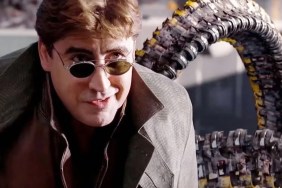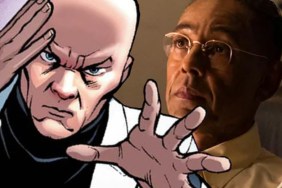The motion capture stage is first and foremost extremely comfortable–warm, with dense, sound proof carpeting for the various capture suit wearing actors–in the building it takes up behind Park Road Post. The room is smaller than your average sound stage, about 20 feet by 20 feet with one entire wall taken up by what visual effects supervisor Joe Letteri calls “the brain box”: four rows of computers for the stages of various system operators feeding options to the rooms cameras, monitors and recorders. But most of the room is given over to the capture stage itself, what Letteri calls “the Volume.” The Volume is the area of the room covered by the active LED cameras ringing the ceiling which ‘see’ and record the movements of anything fitted with a tracking ball in its space.
Despite the common wisdom that performance capture animated films means actors running around miming everything like some avant-garde play, the Volume itself is actually filled with set pieces (or more accurately, pieces of set pieces) during capture. Just as on the computer side, anything an actor intends to interact with, be it door or chair or porthole, has to be built and marked actually on set. Which makes it “difficult to make last minute decisions to have actors grab a book or something; if it’s not built they do have to mime it,” Jackson said.
That said, the sets aren’t what you would normally think of as, well, sets. Because the capture cameras have to be able to see the markers from every angle, sets and props have to be as transparent as possible. They’re all real-life wireframes, made from plain grey aluminum and wire mesh, though that doesn’t mean they’re at all simple. Entire cars, vehicles and rooms were built for the actors to work with. The most complex set piece was probably the plane, Jackson said, which was built as a complete plane to scale with cockpit and switches for Jamie Bell to futz with and a wing and engine compartment for Andy Serkis to climb on (as we saw in the clip earlier). It was also placed on a large gimbal rig in order to simulate movement during capture as realistically as possible.
The necessity for building environments became particularly tricky whenever characters had to venture ‘outside’ Jackson explained, because they also had to build and mark any terrain the actors had to walk on.
Perhaps for that reason he has decided to keep things simple for this demonstration, bringing in a mocked up version of the set for Captain Haddock’s cabin and Tintin’s front hallway. Two actors in marked suits (each of which has to be specifically tailored to the person who is going to wear it) move around at Jackson’s direction while he tracks them with a specially modified video camera. Tethered to the computers by a bundle of cables, the camera itself no longer records – the only thing on it that still works as originally designed is the built-in monitor which shows Jackson what the camera is ‘pointed’ at. The various camera controls have been reengineered to control what would normally take an entire crew on a film set–such as craning, dollying, focus and tracking–with an antenna of tracking balls attached to the top to tell the computer where the camera is.
Jackson quickly and deftly shows how he can make the camera track up Tintin’s front stairs, look down at the two actors who are physically standing next to him, and then track back down, “trying not to trip, then step outside onto a Brussell’s street,” with the actors (standing in at the moment for detectives Thompson and Thompson). All without moving a step except to turn around once.
“Some things you still have to do for real,” he jokes.
For all of this Jackson needs just two people on hand, a grip holding the cables and an assistant communicating by headset with the Brainbox at the other end of the room for more complex controls such as increasing the speed of movement, changing the time of day or lights in the room.

“But it’s not cheaper than live action. Not at all,” Jackson said, as it requires extensively more pre- and post-production time in place of the abbreviated shooting schedule.
Most of that pre-production time was spent on figuring out exactly what the characters of “Tintin” would look like, beginning with paintings and sculptures under the watchful eyes of Weta Workshop’s Richard Taylor and Chris Guise. The main focus of the designers was to transform Hergé’s impressionistic drawings into realistic faces while still looking like their sources. It’s a daunting challenge which has continued into post-production as the animators continue to refine the characters’ looks, with a particular emphasis on their eyes.
“Eyes are the hardest thing,” to capture and animate, Letteri said, but also the most important. “They’re very important,” Jackson agreed. “Since Gollum we’ve been very meticulous about them. Because it’s not just the eyes, it’s all the muscles around the eyes. Everything they do we try to replicate.”
As with the actor’s physical actions, that process begins during capture. Letteri passes around one of the specialized capture helmets which completes the actors’ costumes. A black hard plastic shell that looks like an old-style aviator’s helmet, it is ringed with additional markers for tracking character head movement, plus a small camera suspended in front of the actors faces for the detailed capture of their expressions.
Which is disconcerting to look at, as the locked camera position means the actors’ heads stay in place while the entire world revolves behind them whenever they move. It is an unintentionally dizzying effect which the animators have to constantly search through for reference. Besides the vertigo, the camera presents some new obstacles for the director and the actors because, among other things, “it gets interesting when two actors need to kiss,” Jackson said.
Unlike the current demonstration, Spielberg used the specialized “steering-wheel” controller designed by James Cameron for shooting Avatar to capture “Tintin,” Jackson said. However, he prefers the mocked-up camera for his own performance capture work.
“I just like the feel of a camera in my hands, even though you can use anything,” he said.
Because the capture device, whatever it is, is handheld, original capture material tends to hold that feel as evidenced by the large monitors on the sides of the Volume showing what Jackson is shooting. While some of the shots in the final version of the film will maintain that feel, the actual movement can and will be smoothed out in animation into tracking shots, crane tilts, or even removed entirely. It’s a microcosm of the “Tintin” production experience: the capture process is the heart and soul of the film but it requires considerably more effort than simply slapping detailed computer models on top of the capture data to create the finished product.
A great deal of artistic interpretation is brought into the animation process when determining how much to match original facial expressions. The nature of the process, and particularly of a film like “Tintin” means much of the acting is exaggerated, sometimes over-exaggerated (particularly Serkis). And despite being often within just a foot or so of his actors, the one thing the director can’t do on set is see a rough version of how the faces will animate on his monitors due to the processing requirements of capture. Despite all the high computing power on display, the video on hand is still fairly low on detail to ensure a constant frame rate which is absolutely essential to the capture process.

Still, for some of the limitations unique to the process, the freedom of motion capture also offers a considerably less stressful environment than live-action filming, a further incentive for filmmakers.
“On a live-action set you have hundreds of people working and if it clouds over or rains, which it does from time to time in New Zealand, they’re just sitting there waiting for it to stop and it’s costing hundreds of thousands of dollars,” Jackson said, noting that schedules and budgets can begin stretching very easily, ramping up stresses and pressures with them.
By comparison, a motion capture session can be done anywhere–as witnessed by “Tintin’s” fractured filming process–regardless of the locations called for or number of actors needed as so much can be added in after the fact.
“You can go back to get angles you didn’t think of on the day,” Jackson said, or do very quick pick-up shots, such as they did four months earlier with Bell and Serkis.
But that kind of complete freedom is “a good thing and a bad thing,” Jackson admits. “You try to treat it as a real movie, to keep from going crazy with difficult shots, but sometimes you can’t help yourself,” he said. “You have to know when to stop.”
For all the benefits which come with performance capture animation, Jackson has no intention of giving up live-action filming, believing that each technique has its merits and should be picked as story and tone dictate.
“It’s always nice to see a real person and real emotions,” Jackson said, “but they can exist side-by-side.”
Click here to read more quotes from Spielberg and Jackson. The Adventures of Tintin opens in 3D, 2D and IMAX 3D theaters in North America on December 23.








